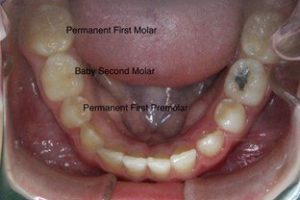Parents often ask me when their child should start orthodontic treatment. As an orthodontist, I also hear people tell me from time-to-time that they think their child is too young for orthodontics when, in my opinion, it would have been great to get started a year ago! So, how do you know when the right time to start treatment is? There are three (maybe 4 or 5) main things that orthodontists look at. Over the next few weeks, I will explain the logic for each thing, so that you, as a parent, can be more informed.
First is the eruption of the premolars and canines. There are different opinions on this. Some orthodontists wait until all of the permanent teeth erupt. Other orthodontists (like myself), like the opportunity to start treatment when there are a few baby teeth left but are expected to be lost within a few months. And here is why:

One of the orthodontic giants, Dr. Hayes Nance, was the first to describe this “leeway space” in his classic journal article The Limitations of Orthodontic Treatment in 1947. He concluded that the leeway space is about 3 millimeters in the maxilla (1.5 mm per side) and about 5 millimeters in the mandible (2.5 millimeters per side.

Unfortunately, children lose their teeth at a wide range of ages, and there is no way to know how long until the baby molars are lost without X-rays. It is possible to lose your last baby tooth when you are 9 years old, however, some children go well into their teens (even as late as 16) before they lose all of their baby teeth.
I hope this has been interesting. Next week for part 2 in this series, I will talk about one of my favorite topics, predicting the onset of a growth spurt to determine the timing of orthodontic treatment!
(NANCE HN. The limitations of orthodontic treatment; mixed dentition diagnosis and treatment. Am J Orthod. 1947;33(4):177-223. doi:10.1016/0096-6347(47)90051-3)

